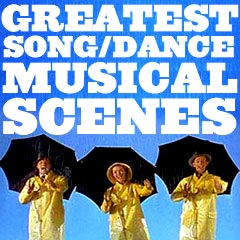
|
Musical Moments and Scenes T |
| T | ||

|
Taking Off (1971) Czechoslovakian film-maker Milos Forman's first American film was an insightful, charming, witty and comedic satirizing of the adult middle-class, with extremely creative editing. It examined the supposed generation gap from the parents' perspective - and was inspired by the Beatles' song "She's Leaving Home." There were many cutaway scenes from the main story - of youth exploitation by counter-cultural judges as many hopeful, talented (and untalented) young female singers and songwriters were auditioned at an open microphone. The singers included film debuts for Carly Simon singing "Long Time Physical Effects", and Kathy Bates as Bobo Bates singing "Even the Horses Had Wings." The most memorable audition was for sweet-faced, long-haired Mary Mitchell (as Herself), who delivered a melodious folk song played very sincerely with a lute - "Ode to a Screw" with dirty lyrics:
|
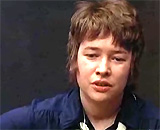 Bobo Bates (Kathy Bates) 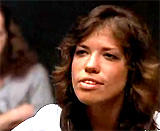 Carly Simon 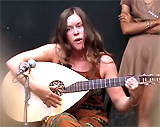 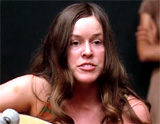 "Ode to a Screw" |
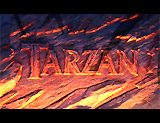
|
Tarzan (1999)
Disney's traditionally-animated musical feature was based on the story Tarzan of the Apes by Edgar Rice Burroughs, and was noted as the first major animated version of the character's story - "King of the Jungle". It won its sole nomination for Best Original Song, You'll Be in My Heart (music and lyrics by Phil Collins) - the first verse of the song was performed in the movie as a lullaby by baby Tarzan's adoptive gorilla mother Kala (voice of Glenn Close) (pictured twice). And then during the end credits, the entire song (by Collins) was heard:
|
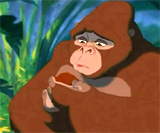 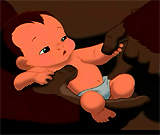
|
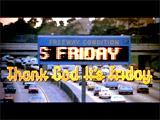
|
Thank God It's Friday (1978)
Director Robert Klane's musical comedy was released at the height of the Saturday Night Fever disco craze. It was not surprising, then, that the film focused on a fictional Los Angeles disco nightclub on La Cienega Blvd. called The Zoo (filmed in an actual nightclub known as Osko's, now demolished), filled with a promiscuous group of singles looking to connect. The film now serves as a time-capsule, cross-sectional glimpse of a moment in time in the late 1970s. There were also early roles for future stars, including Debra Winger and Jeff Goldblum. Although the film won its sole Academy Award nomination for Best Original Song, Last Dance (music and lyrics by AIDS-activist Paul Jabara), the entire film was negatively reviewed by critics as tacky, campy, and superficial. The movie had a vast Robert Altman-like ensemble cast of characters assembled one Friday night at a disco club, and it played like a sitcom version of American Graffiti - with the addition of disco music. Since the musical was a joint Casablanca-Motown production, all of the music and artists were associated with those two labels. Disco music (and performers) were prominently evident in the film, including:
|
  
|
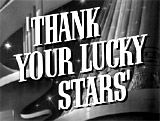
|
Thank Your Lucky Stars (1943) David Butler's and WB's wartime morale boosting, backstage comedy-musical was the studio's response to other similar efforts, including Paramount Pictures' Star Spangled Rhythm (1942) and MGM's Thousands Cheer (1943); it was a typical musical revue or variety show with a large all-star cast and unrelated numbers, serving as a way to raise charitable funds for the war effort:
|
 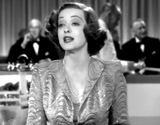 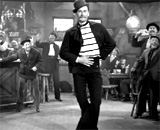 
|
 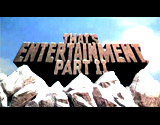 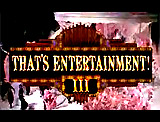
|
MGM's That's Entertainment films (1974, 1976, 1994, 1995) This documentary style trilogy of That's Entertainment movies featured clips of the best known dance routines from musicals in MGM's vaulted files. The first segment featured the stars themselves (Fred Astaire, Gene Kelly, Frank Sinatra, Elizabeth Taylor, Liza Minnelli, Bing Crosby, etc.) introducing and discussing their own clips from such films as Easter Parade (1948), An American in Paris (1951), Showboat (1951), Singin' in the Rain (1952), and many more. The second segment was produced, written and hosted by Gene Kelly while the third segment showed scenes that were cut and never-before-seen, such as:
A fourth direct-to-video film, That's More Entertainment! (1995) featured mostly obscure MGM musical song-and-dance scenes, with a few notable exceptions - the Prehistoric Man song-and-dance number from On the Town (1949), and Sobbin' Women from Seven Brides for Seven Brothers (1954). |

|
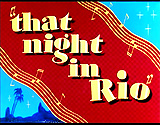
|
That Night in Rio (1941) This Fox musical-comedy from director Irving Cummings was a reworking of Folies Bergère de Paris (1935). The main stars were:
Miranda performed two of her best-known and signature song-dance numbers:
|
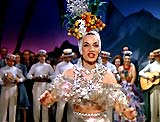 
|
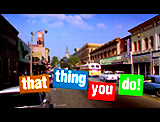
|
That Thing You Do! (1996) Actor Tom Hanks' feature-film directorial debut film featured an early-'60s pop group named The Wonders (aka The One-ders) in Erie, Pennsylvania, a briefly-famous band. The musical band performed many renditions of their debut song - a one-hit wonder literally - the catchy Oscar-nominated Best Original Song - a love-ballad tune titled That Thing You Do:
|

|
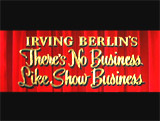
|
There's No Business Like Show Business (1954) This large-scale Irving Berlin song-filled musical featured Dan Dailey, Mitzi Gaynor, Donald O'Connor and headliner Ethel Merman. It was nominated for three Academy Awards (with no wins): Best Motion Picture Story, Best Color Costume Design, and Best Musical Score (Alfred and Lionel Newman). Added on with a tacked-on role was one of Fox studio's biggest draws in the 50s - shapely blonde Marilyn Monroe. Monroe performed two memorable numbers:
|
 
|
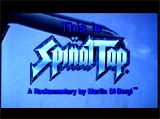
|
This Is Spinal Tap (1984) Director Rob Reiner's debut film was a marvelous satire-spoof on the subgenre of rockumentaries, with its many heavy metal songs written and performed by Spinal Tap (Christopher Guest, Michael McKean, Harry Shearer). The rock band was often showcased with distracting problems occurring during their numbers, including these musical segments:
|
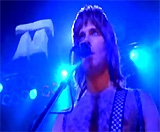 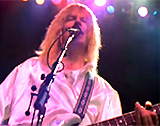
|
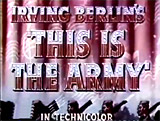
|
This Is The Army (1943) There were almost two dozen patriotic Irving Berlin songs in this Michael Curtiz-directed morale-boosting Warners' film musical adapted from Berlin's 1942 stage tribute to the Army during the two World Wars. The most famous numbers were:
|
 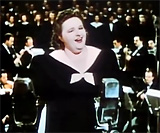  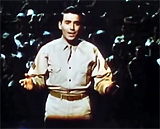 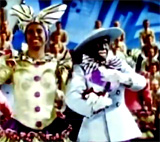 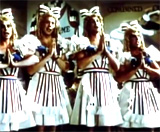 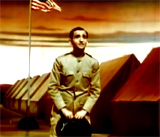
|
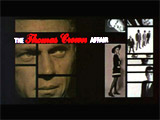
|
The Thomas Crown Affair (1968)
Producer/director Norman Jewison's heist film (remade in 1999 with another version of the Best Original Song by Sting) received two Academy Award nominations and won one Oscar for Best Original Song (The Windmills of Your Mind, music by French composer Michel Legrand and lyrics by Alan and Marilyn Bergman). Its other nomination was Best Score (also Legrand). In the film itself, the song The Windmills of Your Mind (pictured) was sung in the background by Noel Harrison when the title character (Steve McQueen) was at a glider airport in New Hampshire, flying a sleek yellow glider-plane. The lyrics were:
The romantic crime-thriller was most noted for its two stars, robbery suspect Thomas Crown and investigator Vicky Anderson (Faye Dunaway) engaged in a super-sexy chess game scene, part of an on-going cat-and-mouse game between the two. |
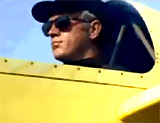  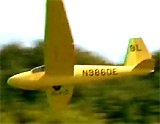
|
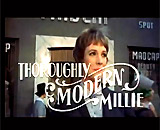
|
Thoroughly Modern Millie (1967) Producer Ross Hunter and director George Roy Hill's overlong musical romantic comedy spoof featured Julie Andrews as the title character - farm girl Millie Dillmount. The musical film won the Academy Award for Original Music Score (composed by Elmer Bernstein). During the opening credits, the title character, naive young Millie 'modernized' herself after noticing that she was woefully out-dated - she entered the Madcap Beauty Spot - and with a short bob haircut and a new dress style was transformed into a NY 'Roaring 20's' "modern" flapper. In the background on the soundtrack, the Oscar-nominated, title song Thoroughly Modern Millie (pictured twice) was sung by Julie Andrews. In the film, she unwittingly resided in a Home for Young Women (a white slavery establishment). Other characters-stars appearing with Andrews included:
There were many other enjoyable musical numbers with Jimmy Van Heusen & Sammy Cahn's 20's-like popular songs, including:
Carol Channing's show-stopping numbers were:
|
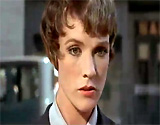 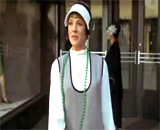 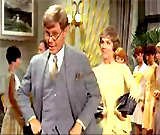 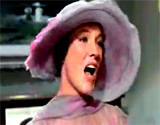 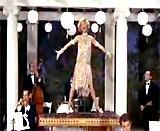 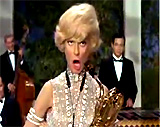 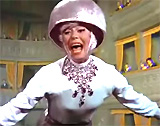
|
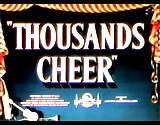
|
Thousands Cheer (1943) MGM's patriotic musical comedy, directed by George Sidney, was released during the middle of WWII, to help boost morale with its uplifting music and songs. The plot was in two parts:
The most popular numbers in the "Big Show" were:
|
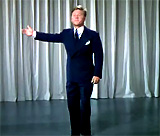 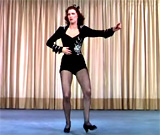 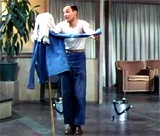 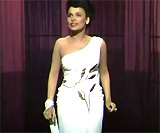 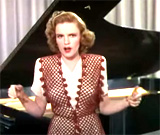 
|
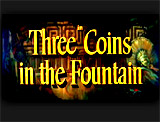
|
Three Coins in the Fountain (1954)
Director Jean Negulesco's romantic comedy was presented in widescreen Cinemascope, and was essentially a beautiful travelogue, mostly filmed on location in Italy (in Rome and Venice). It told of the romantic adventures of three American secretaries looking for love in Rome (the Eternal City), who had tossed coins in the landmark attraction, Trevi Fountain:
Of its three Academy Awards nominations, it won two Oscars: Best Cinematography (win), and Best Original Song (win) (with music by Jule Styne and lyrics by Sammy Cahn), in addition to a nomination for Best Picture. It was remade as The Pleasure Seekers (1964) with Ann-Margret and Anthony Franciosa. The title song, Three Coins in the Fountain (pictured) was sung in a pre-credits sequence by an uncredited Frank Sinatra:
|
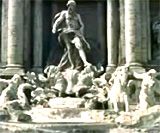 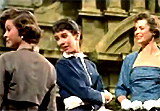
|
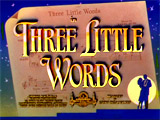
|
Three Little Words (1950) This MGM Technicolored musical biography was about Tin Pan Alley (Broadway) composers/songwriters Bert Kalmar and Harry Ruby. Other musical biopics at the time, produced also by MGM, included:
It included Andre Previn's first score for a major film (Oscar-nominated), and contained 15 hit songs, which were naturally integrated into the movie's plot. The stars included:
Debbie Reynolds also briefly appeared (in her screen debut) and performed I Wanna Be Loved By You (pictured) with a cutesy Betty Boop-like voice (dubbed by the singing voice of the original boop-boop-a-doop girl Helen Kane). Gloria DeHaven sang Who's Sorry Now (pictured) and Astaire joined in a duet with Skelton (on the piano) for So Long, Oo-Long (pictured). And Arlene Dahl sang a beautiful version of I Love You So Much (pictured). Dance-song numbers included:
|
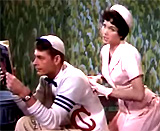 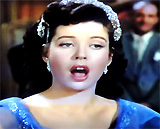 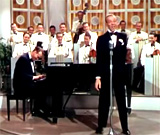   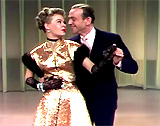 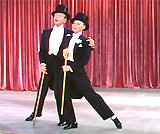  
|
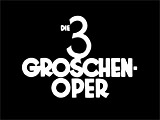
|
The 3 Penny Opera (1931, Germ.) (Die 3 groschenoper) G.W. Pabst's early 1930s black and white German musical, with music by composer Kurt Weill, was loosely based upon the 1928 Bertoldt Brecht theatrical production of The Threepenny Opera (itself a legendary adaptation and transformation of John Gay's 1728 British operetta The Beggar's Opera). The main anti-hero character was Mackie Messer (aka MacHeath or "Mack the Knife") (Rudolf Forster), a ruthless, authoritarian, and unperturbed dapper captain of underworld thieves in Soho of Victorian London. The film's most popular number Mack the Knife (pictured) was performed by a Street Singer (Ernst Busch) on a stage to an audience - the character regularly interjected himself into the movie as a master of ceremonies or Greek chorus while recounting Mack's murderous deeds - he even addressed the audience directly. |
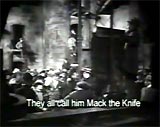
|
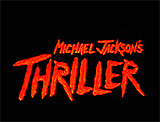
|
(Michael Jackson's) Thriller (1983) This 13-minute mini-film (music video) of the pop music song was released theatrically for Oscar eligibility and directed by John Landis. The VHS home video release titled "The Making Of Michael Jackson's Thriller" became the world's top-selling VHS musical. Besides being the most expensive video and world's longest music video at the time, it was one of the most famous screen group dances ever performed - by an undead Michael Jackson and zombies in a graveyard, and it also featured horror film star Vincent Price as narrator. |
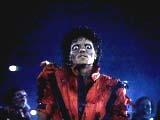
|
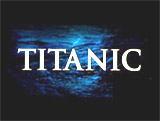
|
Titanic (1997)
The blockbuster disaster film from James Cameron, besides its dazzling visual effects and melodramatic story, was bolstered by James Horner's evocative award-winning soundtrack. Among many other awards, the film won the Oscar for Best Original Dramatic Musical Score and Best Original Song. Canadian singer Celine Dion sang the iconic, overly-emotional hit theme song My Heart Will Go On (pictured) - a love theme written by Horner (with lyrics by Will Jennings). It won the Academy Award for Best Original Song, and it became Dion's biggest hit (and signature song), and one of the best-selling singles of all time (and the world's best selling single of 1998). However, it soon became tiresome by being over-played on the radio. But the song wasn't ever performed in the film itself, but played only in the background during the closing credits. |

|
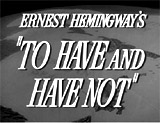
|
Howard Hawks' wartime adventure masterpiece was set in an exotic locale in the Caribbean (WWII Martinique). Early in the film, local cafe pianist Cricket (writer/singer Hoagy Carmichael) sang Am I Blue? (pictured), while accompanied by stranded American Marie Browning (Lauren Bacall) dressed in a grey checkered suit. In a scene toward the conclusion, Cricket was also at the piano playing Hong Kong Blues (pictured). It was a bluesy song about "a poor unfortunate colored man who got arrested down in old Hong Kong." The lyrics of Hong Kong Blues described a man in a foreign land far away from home ("the land of the free" in Frisco) who wished to return home to find happiness once again:
|
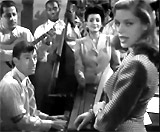 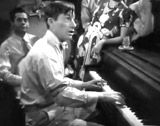
|
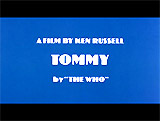
|
Tommy (1975, UK) This Ken Russell-directed surrealistic feature film was a rendering of rock group The Who's landmark psychedelic "rock opera" Tommy - composed by guitarist Peter Townshend. It had two Academy Award nominations: Best Actress (Ann-Margret) and Best Original Song Score and/or Adaptation (Peter Townshend). It quickly became a cult film, with its many stars and performances:
There were appearances by Elton John for the song Pinball Wizard (pictured), and Tina Turner performing Acid Queen (pictured). Memorable numbers also included:
|
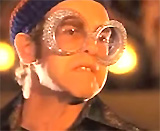  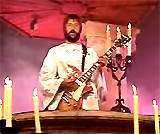
|

|
Top Gun (1986)
Director Tony Scott's loud action-buddy film was the highest-grossing (domestic) film of the year, at $176.7 million, partially due to its spectacular action-based aerial dogfight sequences. The action flick starred 23 year-old Tom Cruise as swaggering fly-boy Lieutenant Pete "Maverick" Mitchell, soon to become the biggest star of the decade. [Inflation adjusted, the film remains Cruise's biggest hit of his entire career.] Its sole Oscar win (from four nominations in technical categories) was for Best Original Song, recorded by Berlin: Take My Breath Away (pictured often) (with music by Giorgio Moroder and lyrics by Tom Whitlock). It was heard at the start of a romantic scene between Maverick and his female instructor, Charlotte "Charlie" Blackwood (Kelly McGillis), filmed with silhouettes and blue hues. After sleeping together, "Charlie" pleasantly awoke to a note from him folded in the shape of a fighter jet. Kenny Loggins' Danger Zone was also a popular song on the soundtrack, but un-nominated. |
 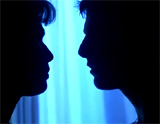 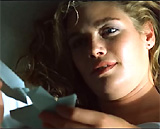
|
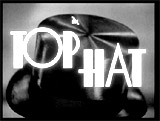
|
This profitable RKO and Best Picture-nominated film marked the fourth pairing of Astaire and Rogers - and was the star-making film that catapulted them to legendary status:
It was set within the backdrop of an art-deco Venice with a plot about mistaken identity, accompanied by a number of Irving Berlin tunes (it was Berlin's first screen musical):
|
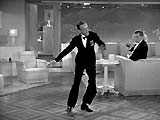   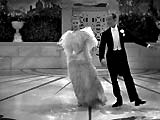
|
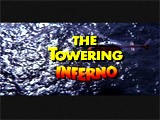
|
The Towering Inferno (1974)
Jointly produced by Fox Studios and Warners and directed by John Guillermin (with action sequences directed by producer Irwin Allen), this highly-profitable, lengthy drama-action disaster film had a total of eight Oscar nominations (including Best Picture, and Best Score by John Williams) and won three awards: Best Original Song, Best Film Editing, and Best Cinematography. Two years earlier, the theme song for Irwin Allen's other disaster film also won the Academy Award for Best Original Song (for The Morning After). As in many other disaster films of the 1970s, an all-star cast (including Paul Newman, Fred Astaire, William Holden, Jennifer Jones, Faye Dunaway, O.J. Simpson, Steve McQueen and more) was placed at the scene of a "towering inferno" - an 138 story glass-towered structure in the heart of San Francisco that was burning and threatened many lives. The song We May Never Love Like This Again was written by Al Kasha and Joel Hirschhorn, and thematic song elements were often heard throughout Williams' musical score. The song itself was performed by singer Maureen McGovern (as Herself) in the film (pictured), in a cameo role as a blonde lounge singer, who was entertaining guests as they danced in front of her during a dinner party. |
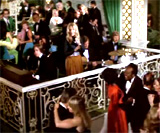 
|
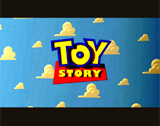
|
Most of the songs in this Disney/Pixar milestone animated film, the first feature-length computer-animated film ever, were written, performed, and produced by Randy Newman (Oscar-nominated for Best Original Music Score), including the Oscar-nominated Best Original Song You've Got a Friend in Me (pictured). A third Oscar nomination was for Best Original Screenplay. A world of anthropomorphic toys included the two main rival characters:
You've Got a Friend in Me (pictured thrice) played during the opening credits when six year-old human owner Andy Davis (voice of John Morris) took his favorite toy Woody downstairs, by sliding him down the banister and catching him. It was also sung as a duet between Randy Newman and Lyle Lovett during the end credits. |
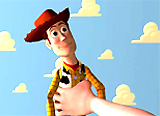 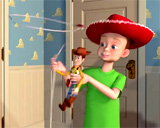 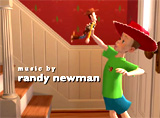
|
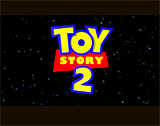
|
Toy Story 2 (1999) This sequel (the third Disney/Pixar feature film after Toy Story (1995) and A Bug's Life (1998)) featured the melancholy Oscar-nominated Best Song When She Loved Me (pictured) (sung by Sarah McLachlan) with a flashback of cowgirl doll Jessie (voice of Joan Cusack) experiencing being loved, forgotten, and ultimately abandoned by her owner, Emily. Another touching and climactic moment came when Woody (voice of Tom Hanks) saw his black-and-white television puppet counterpart on the 1960s "Woody's Roundup" show singing You've Got a Friend in Me (nominated for an Oscar in the original Toy Story (1995)), making Woody realize his significance as a toy to a child. In the finale, the penguin squeeze toy Wheezy (voice of Joe Ranft) belted out, Vegas and Sinatra-styled (with Robert Goulet's voice): You've Got a Friend In Me (pictured), accompanied by a trio of Barbie backup singers. |
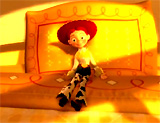 
|
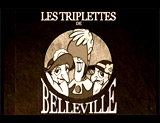
|
The Triplets of Belleville (2003, Fr.) (aka Les Triplettes de Belleville) This Oscar-nominated, PG-13 rated, Belgian-French-Canadian animated-comedy feature film was mostly composed of songs with very little dialogue. The Belleville Triplets (now elderly) were music hall singers from the 1930s:
There was black-and-white archival footage of their song-and-dance of the Oscar-nominated Best Original Song Belleville Rendez-Vous (pictured) - it was a 30s style cartoon parody which featured caricatures of:
In their old age, the dancing Triplets entertained on stage - during a jam session of their cabaret/skiffle act (pictured), using household items (newspaper, refrigerator metal shelves, vacuum cleaner, bicycle wheel and a hatbox) as mad instruments. |
 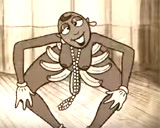 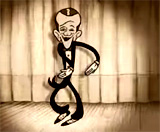 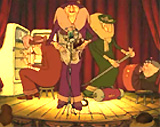
|
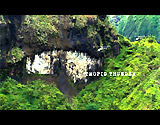
|
Tropic Thunder (2008) Director/star Ben Stiller's action comedy was about a cast of amateur actors who were in the midst of filming a Vietnam War veteran's memoirs, titled Tropic Thunder, in a tropical jungle. The producer of the ill-fated film was balding, foul-mouthed, bearded, glasses-wearing, disagreeable, middle-aged film executive Les Grossman (Tom Cruise in a fat suit with a bald cap, in an uncredited cameo), who performed one very memorable dance (the song-dance brought back memories of Cruise's underwear dance in Risky Business (1983) twenty-six years earlier). During the film's ending credits in a hip-hop dance scene, he performed a bump-and-grind dance, including air-spanking himself while dirty-dancing, to the tune of Ludacris' gangsta rap song Get Back (pictured), littered with obscene lyrics. (Earlier in the film, he also briefly danced to rapper Flo Rida's Low.) |
 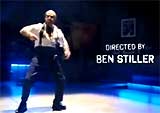
|
(alphabetical by film title) Introduction | A-1 | A-2 | B-1 | B-2 | B-3 | C-1 | C-2 | D-1 | D-2 | E | F-1 | F-2 | G-1 | G-2 H-1 | H-2 | I-J | K | L-1 | L-2 | M-1 | M-2 | N-O | P-1 | P-2 | R-1 | R-2 | S-1 | S-2 | S-3 | T | U-V | W | X-Z |